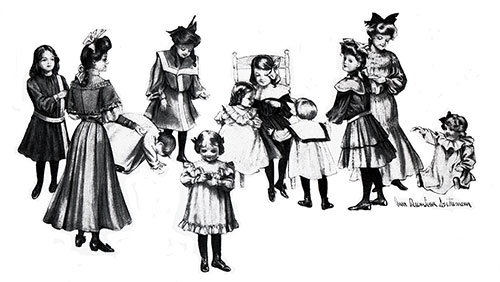Late Winter Styles for Young People February 1904

STYLES for children are designed with an eye to simple effects and individual becomingness, and in details only are novelties introduced. There are odd collars which take lines entirely new, and different ways of putting on trimmings.
Some of these methods are revivals of other times. A trimming idea that suggests the days of the prunella gaiter is to have bands of ribbon velvet or gimp in graduating widths put on in deep points on the full gathered skirt.
The dainty guimpe of white lawn, nainsook, etc., is the feature of nearly every dress the girl of from six to twelve years will wear. Its fresh, crisp charm is appreciated by the mother who takes pride in her little daughter’s appearance.
Guimpe dresses are included in every juvenile outfit, and also dresses that are made in one piece, a belt usually being worn. Some of the box-plaited, one-piece dresses have the Russian closing, and the designs suggest very pretty braid and button decorations.
Navy-blue serge will prove most satisfactory for these little costumes. Other colors may be used, and braid, in which there is a glint of gold, and tiny gold buttons, are the preferred trimmings.
No Winter materials are more suited to youth than are the brilliant plaid stuffs, which the merest thread of black velvet trims prettily. The genuine Scotch tartans, of course, follow the colorings and patterns of the clans, so that the deep green and blue and black design of time- honored memory is still seen.
This, softened with black velvet, is always stylish, but the more becoming plaids introduce vivid shades of red and green.
Brown, black and orange plaid is a pretty combination that will develop charmingly by a design that has box-plaits down the center of the front and back of both the blouse body and skirt— the material is bias—the yoke of pale yellow silk being outlined around the lower edge with a bertha strap of brown velvet. The fancy cuffs are also of the brown velvet, as well as the narrow-stitched belt.
Another stylish frock for a girl of ten or twelve years consists of a blouse and a five-gored kilt skirt that is attached to an under-body. A pretty touch is given in the linen Eton collar, which is removable. Cuffs of the linen may also be worn, and a patent-leather belt gives good style.
Plain, solid- colored materials—serge, cheviot and light-weight cloth— would preferably be selected for this little frock, the simplicity of which is its greatest charm.
For maids of twelve or fourteen years, cape effects, shoulder epaulette bands and plaited skirts are points of style to be considered, and no matter how plain the gown, a picturesque sleeve is sure to give it distinction. The insertion puff is perhaps the favorite for very young girls.
A charming suggestion for the development of soft woolens in pale, delicate colors is a mode having a blouse which may be worn with a guimpe, with the neck in Dutch or low round style, and the sleeves in elbow length.
A fancifully outlined bertha is an interesting feature and offers many trimming possibilities. The straight full skirt may have the ruffle or deep hem around the bottom.
Perhaps the most important item in the small maid’s Winter outfit is her coat; and to be strictly up-to-date it must be military in effect, if not in shape. For its development handsome cloth, zibeline or velvet will be used, and braid and buttons will provide the decoration.
An exceptionally stylish mode is a tucked long coat with military closing, which can be made with or without the epaulette capes or shoulder straps. Another coat is in double-breasted military style with a deep cape. A strap or rolling collar may be used, and there may be a back strap if desired.
The quaint, picturesque “1830” styles are quite as popular for the young miss as for her elders, and the dainty, soft materials of silk or wool that abound in the shops, lend themselves admirably to these modes.
A charming dress in “1830” style, for which a delicately patterned challis was used, consists of a blouse waist, the neck of which may be high or in Dutch or low round style, with a bolero and a five-gored skirt that may be tucked, plaited or gathered at the waist.
Shirt-waists are essential to the young miss’s wardrobe, and there are many and varied styles from which to choose. For the “tub’’ waist the design will be plain, while one may indulge her tastes for frills and tucks in those that are made of silks, soft wool goods and sheer fabrics.
Terminology
Guimpe: a high-necked blouse or undergarment worn showing beneath a low-necked dress. (Oxford University Press)
“Late Winter Styles for Young People,” in The Delineator: An Illustrated Magazine of Literature and Fashion, Paris-London-New York-Toronto: The Butterick Publishing Co. Ltd., Vol. LXIII, No. 2, February 1904, p. 215.
